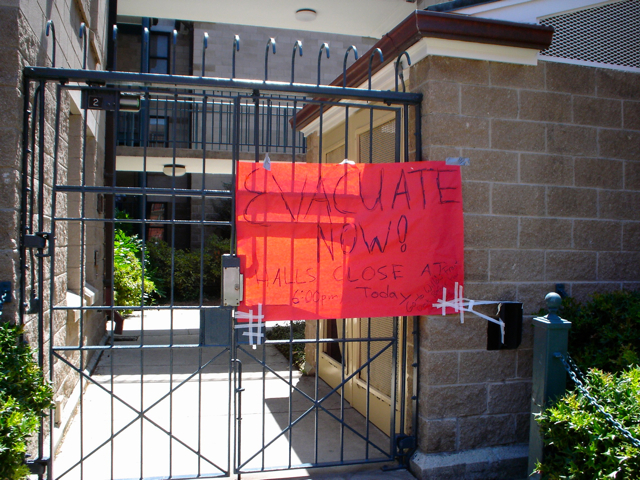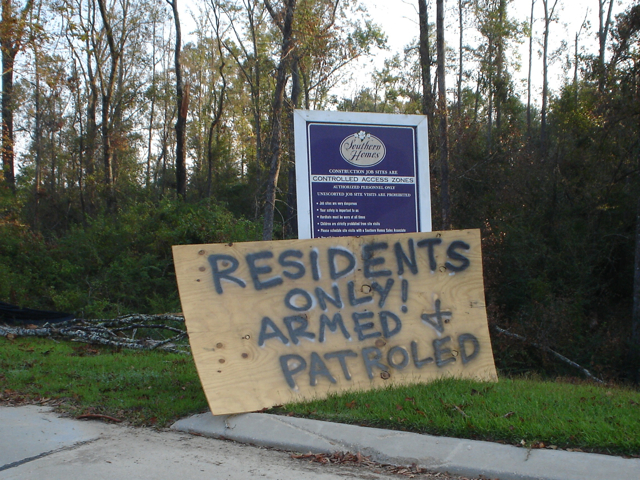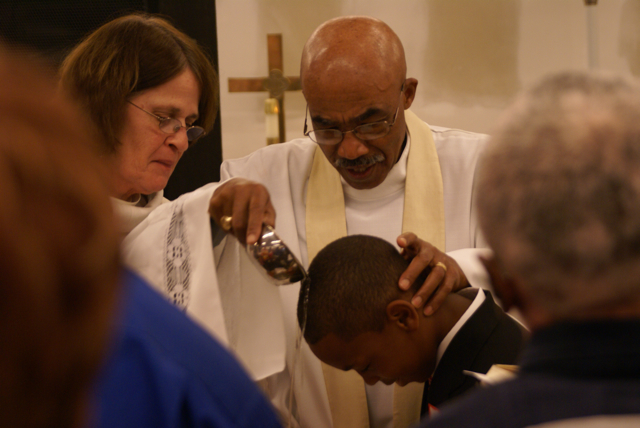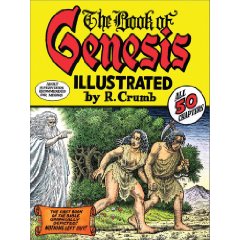This is the paper I presented to the Chronicle-Ezra-Nehemiah and Exile combined session. I was invited to speak about how the destruction and restoration of Jerusalem can be understood through the waters of Katrina. I have images that go with this (see a few images from Katrina at my flickr account) that I will post eventually and I recored the audio as well and I hope to have that up later as well.
Restoration and Recovery Through Scripture
By 8:30 am on Saturday August 27, 2005 I was standing in front of Butler Hall, the honors dorm on Tulane University’s campus, talking with Rabbi O_____ and his wife. I was entering my 9th year at Tulane and my second as director of the Honors Program. The O_____s were moving there third child and third honors Tulanian into Butler. Their twin daughters had been my students 3 years earlier and now their son was joining them in New Orleans. (Curiously enough, given where I would end up 12 months later, the O_____s had recently moved to State College, PA.) It was a typical hot and muggy August day and we had our honors banner up and our returning students were already moving nervous freshmen into the dorm. By 11 am we had signs posted saying, “Evacuation! All students must evacuate campus by 6 PM.”
 Hurricane Katrina was on her way and while we now know that it would be the deadliest and costliest hurricane in US history at the time it was simply another evacuation. Each year for seven years in a row, my wife and I with our young children had evacuated at least once. In our second year tropical storm Francis had brought so much flooding, nearly entering our raised house that we were renting, that when it came time to purchase a home we intentionally moved across Lake Ponchetrain, a 65 mile commute for me, so that when it inevitably came time to evacuate we would not have to cross either the Mississippi or the lake. And so after seeing that all of our students and staff were evacuated, on Sunday my wife and I boarded the windows on our new house and packed the kids in the car and made our way to our friends in Mississippi. It turns out we would have been safer at home.
Hurricane Katrina was on her way and while we now know that it would be the deadliest and costliest hurricane in US history at the time it was simply another evacuation. Each year for seven years in a row, my wife and I with our young children had evacuated at least once. In our second year tropical storm Francis had brought so much flooding, nearly entering our raised house that we were renting, that when it came time to purchase a home we intentionally moved across Lake Ponchetrain, a 65 mile commute for me, so that when it inevitably came time to evacuate we would not have to cross either the Mississippi or the lake. And so after seeing that all of our students and staff were evacuated, on Sunday my wife and I boarded the windows on our new house and packed the kids in the car and made our way to our friends in Mississippi. It turns out we would have been safer at home.
When all had died down by Monday afternoon the little town in MS to which we had evacuated was nearly destroyed. Tall pines were down across homes and streets and the power was out in the entire region. We awoke early Tuesday morning and drove the two hours back to our house, passing abandoned cars and uprooted trees. It was amazingly quiet and eery. In spite of the cell phones not working and local radio stations down, the XM satellite radio in our car enabled us to hear the audio of the major news channels. To this day I have not seen the grocery cart that MSNBC kept describing as going 60 MPH across the parking lot of our local WalMart. When we arrived in our neighborhood, a newly planned community where a wood had been cleared for the houses, we found very little damage. Our home was fine. A mere two miles away, the house next to the one we had just sold the year before was crushed under three pine trees. Tornadoes had ripped through old Covington and left paths like a snake crawling across the sand. There was no power, no water, and no sewage. After a day of cleanup we decided that it would be safest and best for our family, our son was only 1 and a half years old and our daughter was just about to turn 8, if we evacuated to my brother’s house in OH. We remained there for 9 days, until the power had returned to our neighborhood.
 You all know that the recovery had just barely begun by the time we returned to our home, but we often forget that the recovery continues 4 years later and will likely continue for years to come. Indeed, we could argue that NOLA has been in a state of continual recovery since the first European settlers tried to tame the native communities and lands, constantly and incompletely coping with the natural, political, and social upheavals that are as much a part of this tropical port city as gumbo or jazz.
You all know that the recovery had just barely begun by the time we returned to our home, but we often forget that the recovery continues 4 years later and will likely continue for years to come. Indeed, we could argue that NOLA has been in a state of continual recovery since the first European settlers tried to tame the native communities and lands, constantly and incompletely coping with the natural, political, and social upheavals that are as much a part of this tropical port city as gumbo or jazz.
In this paper I was going to try to examine how the priest-scribe Ezra restores Torah to Israel and consider, by way of analogy, similar use of Scripture by New Orleans’ clergy and leaders in the wake of Hurricane Katrina. As I did the research for this approach I realized that I would end up spending most of my time providing appropriate caveats and considerations for opposing views regarding the restoration of Jerusalem, the historicity of Ezra’s promulgation of the Law, and other such matters that are extremely important and I understand as the usual grist for the mill of this section. In so doing I would lose, however, the opportunity to reflect more broadly on what has happened to NOLA and how the experience here can inform and be informed by the ancient events surrounding Jerusalem in the 6th and 5th centuries BCE.
When I teach students about the destruction of Jerusalem by the Babylonians I always take great pains to point out to them how completely devastating this event was. Judaism and Christianity today are so far from any notion that one may only worship in a single place that most students cannot comprehend what it meant to lose “the footstool of God.” This was the one place where proper sacrifices could be offered1 and it was the symbol of God’s presence with his people. But it was not just the temple that was destroyed; Jerusalem was heavily damaged, if not razed, and a large percentage of the existing Jews were killed. If we want to think in comparative terms then it is worth realizing that Judaism was in greater danger of being eliminated in 586 BCE than it was in the 1940s. By the time of Hitler Jews lived throughout the world. Yet in the 6th century BCE most were the residents in and around Jerusalem and they all might have been eliminated as so many other peoples before them.
Of course not only did they survive but so did their religion. The people were now scattered across the region and the temple destroyed yet they somehow they maintained their identity and their ability to worship. They did this largely by making the Torah central to their religious life. From the references to Daniel praying towards Jerusalem in Daniel 6 to the reading of and appeal to the Law throughout Ezra-Nehemiah, whatever our questions and reservations regarding the historicity of a specific recital of the Law at the Water Gate, the Law and its study became of central importance to Jews and Judaism.
As I pass quickly over historical considerations, I should pause, however, and note that it is the very confusion of the history of Jerusalem’s reconstruction that reminds us that recovering from such a disaster does not happen quickly or easily. No matter how we envision the rebuilding of Jerusalem or the reconstruction of the text of Ezra-Nehemiah, it took multiple generations for Jerusalem to become stable and secure. If Rome was not built in a day Jerusalem was not rebuilt in a week. As noted, NOLA is no different. What takes so much effort is not, however, the reconstruction of the physical structures, even though the walls of Jerusalem remained in rubble for years as much of the lower Ninth Ward remains desolate today. What takes far longer to rebuild and repair is the spirit and heart of a community. For ancient Judaism the Torah was slowly taking the place of the temple as the locus of that spirit and heart.
As ruling powers ebbed and flowed and local challenges and challengers continued to present themselves the now dispersed Jewish community went on with their lives. The temple and its restoration remained a priority but the Law itself was becoming the center of Judaism and its study and recital the means of expressing allegiance and devotion. It was this that allowed Judaism to survive the long slope of recovery and prepared it to endure many future calamities.
As I suggested earlier, the destruction of 586 BCE and its aftermath was perhaps the most pivotal period in Jewish history. In learning to cope both theologically and practically with the loss of the Temple and their homeland through a focus upon the Torah and its study, Judaism adapted in a way that would ensure its continued survival. The evidence of God’s presence with his people and their demonstrations of loyalty no longer relied upon a physical structure that could be destroyed (or merely difficult to get to) or even upon its priests (although those changes were undoubtedly slower in coming). Instead one needed simply a copy of the Law itself and someone knowledgeable enough to read and interpret it. It is significant that Ezra is described as not simply a priest, but also as “a scribe skilled in the law of Moses that the LORD the God of Israel had given.” Knowledge and dissemination of the Law was now on par with the ability to serve in the Temple.
Thus in the aftermath, even many centuries later, it was through Scripture that Jews tried to come to terms with how God could have allowed such destruction to happen. We shall see that at least for some people, the same was true in the days, weeks, and years following Katrina.
The Book of Lamentations is probably our earliest example of reflection upon the destruction of Jerusalem and the temple. Most scholars hold that at least some of the poems are from those who survived the nearly two year long siege and within their laments we find the deep passion of their grief. Yet in the midst of their mourning the poet of chapter 1 declares that it is the people of Jerusalem who are culpable.
Lam. 1.5 Her foes have become the masters,
her enemies prosper,
because the LORD has made her suffer
for the multitude of her transgressions;
her children have gone away,
captives before the foe.
Within Ezra-Nehemiah we find similar though more distanced reflections.
Ezra 9:7 From the days of our ancestors to this day we have been deep in guilt, and for our iniquities we, our kings, and our priests have been handed over to the kings of the lands, to the sword, to captivity, to plundering, and to utter shame, as is now the case.
Neh. 1:7 We have offended you deeply, failing to keep the commandments, the statutes, and the ordinances that you commanded your servant Moses. 8 Remember the word that you commanded your servant Moses, ‘If you are unfaithful, I will scatter you among the peoples; 9 but if you return to me and keep my commandments and do them, though your outcasts are under the farthest skies, I will gather them from there and bring them to the place at which I have chosen to establish my name.’
We could of course add any number of other biblical passages from other books that do the same as these presented, assuring the audience (and God) that the tragedy of Jerusalem’s destruction was the result of Israel’s disobedience and not God’s capriciousness or incapacity. But will be faithful and according to his word will restore his people if they are faithful to his word.
Not surprisingly, later rabbinic material does the same. The Targum of Lamentations expands and embellishes the biblical text of Lamentations so that there can be no doubt about Israel’s culpability and God’s righteousness. Furthermore the Targum calls the contemporary community to right worship and devotion to God through the study of Torah and Mishnah.
TgLam 2:19 Arise, O Congregation of Israel dwelling in exile. Busy yourself with Mishnah in the night, for the Shekinah of the Lord is dwelling before you, and with the words of Torah at the beginning of the morning watch. Pour out like water the crookedness of your heart and turn in repentance. And pray in the synagogue before the face of the Lord. Raise your hands to him in prayer for the life of your children who thirst with hunger at the head of every open market.
Whether immediately following the destruction or over 1,000 years later reflecting upon the destruction of not one but two temples, the study of and obedience to the Torah was seen as the means through which the community might endure their hardships.
Finally, to turn to our own situation, it is of course obvious that there is no clear analog to what happened here in New Orleans. The “temple” of New Orleans, if we were to try and identify one, would be the French Quarter and it was left largely untouched and Mardi Gras went ahead as usual in the spring of 2006. And we all know that for most moderns it is extremely simplistic to see a natural disaster such as Katrina as evidence of God’s displeasure. So when Christian conservatives like Pat Robertson and John Hagee claimed that God brought Katrina upon New Orleans because of its notorious sins, observers such as Stephen Colbert were right to point out that since those whose homes were destroyed were mostly from the church-going Ninth Ward and the French Quarter was largely unscathed, clearly God doesn’t hate the gay, “God hates the Gay adjacent.”
Others, however had more sensitive and thoughtful reflections. In his first sermon 11 days after Katrina Rabbi Jeff Kurtz-Ledner of the Northshore Jewish Congregation in Mandeville reflected upon the challenge of reading Scripture after catastrophe. A friend had told him how difficult it was to read Psalm 29 just a week after the waters of Katrina had inundated portions of the city.
I read it just prior to services and immediately I was inspired to re-interpret. For what had been a Psalm of sorrow for my colleague immediately became a Psalm of reclamation and rededication.
Because among the verses of Psalm 29 we read:
The voice of the LORD is over the waters; the God of glory thunders, the LORD, over the mighty waters. The voice of the LORD is power;
the voice of the LORD is majesty; the voice of the LORD breaks cedars; the LORD shatters the cedars of Lebanon.
The LORD sat enthroned at the Flood; the LORD sits enthroned, king forever.
Where was God? We sat there with homes having been destroyed by the mighty waters, houses damaged by shattering and broken pine and oak trees.
And I read the Psalm to the congregants without comment, and we sat silently, and thought, and I read it again, but I declared that we would re-read this Psalm with an interpretation.
Because God was there for us. God was not absent.
Because the voice of the Lord IS over the waters, and when the mighty waters broke through and devastated the city, God was not absent.
For my friend Rabbi Kurtz-Ledner the storm was not evidence of God’s absence or his lack of caring, it was a reminder that God is lord over everything, even the mighty destroying waters. He further reflected on the comments of Neil Yerman, a Torah scribe who came to the Northshore to help them in the week following the storm.
Nature is not evil. Nature is the way God created the world, and sometimes nature’s fury damages us, but during these times God is there. [Neil] spoke of the living waters of the Torah, reminding us that as we suffered from the killing waters of Katrina that God replenishes our soul with the living waters of the Torah.
And just yesterday morning I sat in a service with the Episcopal Bishop of Louisiana the Right Reverend Charles Jenkins at All Souls church in the lower Ninth Ward still reflecting upon these muddy waters. This church is a barely converted Walgreens drugstore that the company donated to the diocese in the days immediately following the storm. It is slowly being converted into a house of worship, but still today the floors are broken tiles, the bracket for the security monitor hangs from the ceiling, and the walls, while patched, are not painted. This would be the Bishop’s last visitation of this new parish since he will be retiring in just a few weeks. As we drove in I noted the many homes that remain as they were four years ago, blue tarps still flapping from the roofs.
Bishop Jenkins’ sermon focused upon the dignity of all people, a dignity that he said derives from the facts he knows from Scripture, that we were all created in the image of God and that God allowed himself to be made manifest in human form. That is why, he said,
You cannot let anyone take away your dignity. They called us refugees. Refugees! In our own country. But do not let anyone take away your dignity. We were created in the image of God and that means that we are God’s people and are to be respected and treated with dignity.
 The foundation of Jenkins’ conviction is found in his Scripture, both the Old and New Testament, that affirm that even in the midst of death and suffering, God remains and we remain as his reflection, worthy of respect.
The foundation of Jenkins’ conviction is found in his Scripture, both the Old and New Testament, that affirm that even in the midst of death and suffering, God remains and we remain as his reflection, worthy of respect.
For Bishop Jenkins and for so many Katrina may have left this city four years ago but her presence is still felt. Recovery is a long an arduous process, as Ezra-Nehemiah makes clear, and it is full of conflicting emotions and experiences. When the temple’s foundations were laid we are told that the some wept, but many cheered, “so that the people could not distinguish the sound of the joyful shout from the sound of the people’s weeping.” As Jeff Kurtz-Ledner rereads the psalms he finds both the destructive force of the water and the presence of God. And Bishop Jenkins reminds his community that they have been baptized twice, “once in the church and once in the dirty waters of Katrina.”
—-
1. Although we know, of course, that there were always many other places and other sacrifices.



3 thoughts on “SBL Paper: Recovery and Restoration Through Scripture (images)”
Chris, just noting this for the carnival and I spotted that you blank the name of the family twice, and appear to give it in full as O______ between the two blanked out names!
Thanks Doug! ANd I hope you don’t mind my redacting your comment, for obvious reasons.